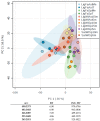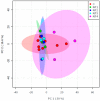How Environmental Factors Affect the Production of Guanidine Alkaloids by the Mediterranean Sponge Crambe crambe
- PMID: 28621725
- PMCID: PMC5484131
- DOI: 10.3390/md15060181
How Environmental Factors Affect the Production of Guanidine Alkaloids by the Mediterranean Sponge Crambe crambe
Abstract
Most marine sponges are known to produce a large array of low molecular-weight metabolites which have applications in the pharmaceutical industry. The production of so-called specialized metabolites may be closely related to environmental factors. In this context, assessing the contribution of factors like temperature, nutrients or light to the metabolomes of sponges provides relevant insights into their chemical ecology as well as the supply issue of natural sponge products. The sponge Crambe crambe was chosen as a model due to its high content of specialized metabolites belonging to polycyclic guanidine alkaloids (PGA). First results were obtained with field data of both wild and farmed specimens collected in two seasons and geographic areas of the North-Western Mediterranean. Then, further insights into factors responsible for changes in the metabolism were gained with sponges cultivated under controlled conditions in an aquarium. Comparative metabolomics showed a clear influence of the seasons and to a lesser extent of the geography while no effect of depth or farming was observed. Interestingly, sponge farming did not limit the production of PGA, while ex situ experiments did not show significant effects of several abiotic factors on the specialized metabolome at a one-month time scale. Some hypotheses were finally proposed to explain the very limited variations of PGA in C. crambe placed under different environmental conditions.
Keywords: abiotic factors; metabolomics; specialized metabolome; sponge; sponge farming.
Conflict of interest statement
The authors declare no conflict of interest.
Figures







References
-
- Becerro M.A., Turon X., Uriz M.J. Multiple Functions for Secondary Metabolites in Encrusting Marine Invertebrates. J. Chem. Ecol. 1997;23:1527–1547. doi: 10.1023/B:JOEC.0000006420.04002.2e. - DOI
-
- Assmann M., Lichte E., Pawlik J.R., Kck M. Chemical defenses of the Caribbean sponges Agelas wiedenmayeri and Agelas conifera. Mar. Ecol. Prog. Ser. 2000;207:255–262. doi: 10.3354/meps207255. - DOI
-
- Engel S., Pawlik J.R. Allelopathic activities of sponge extracts. Mar. Ecol. Prog. Ser. 2000;207:273–281. doi: 10.3354/meps207273. - DOI
-
- Genta-Jouve G., Croué J., Weinberg L., Cocandeau V., Holderith S., Bontemps N., Suzuki M., Thomas O.P. Two-dimensional ultra high pressure liquid chromatography quadrupole/time-of-flight mass spectrometry for semi-targeted natural compounds identification. Phytochem. Lett. 2014;10:318–323. doi: 10.1016/j.phytol.2014.10.029. - DOI
MeSH terms
Substances
LinkOut - more resources
Full Text Sources
Other Literature Sources

